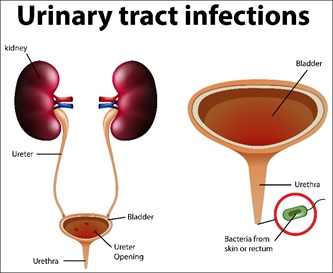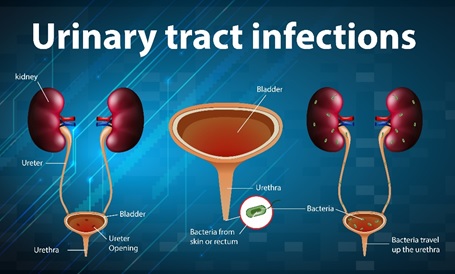Urinary Tract Infections (UTI) - Prevention and Management

A urinary tract infection (UTI) is an infection in any part of your urinary system � your kidneys, ureters, bladder, and urethra. Most infections involve the lower urinary tract � the bladder and the urethra.
�
Women are at a greater risk of developing UTI than are men. This is because of the anatomy of female urinary tract as their urethras are shorter in length compared to males making them more at risk. (Figure 1). Infection limited to your bladder can be painful and annoying. However serious consequences can occur if a UTI spreads to your kidneys.

Figure 1: Female versus male urinary system
Causes of UTI.
Most urinary tract infections (UTIs) are caused by the bacterium�Escherichia coli (E. coli), usually found in the digestive system.�Chlamydia and mycoplasma bacteria can infect the urethra but not the bladder.�
�
UTIs are given different names depending on where they occur. For example:
- A bladder infection is called�cystitis.
- A urethra infection is called urethritis.
- A�kidney infection�is called pyelonephritis.
The ureters are very rarely the site of infection.
�
Risk factors
The following factors can�increase the likelihood�of developing a UTI:��
- sexual intercourse, especially if more frequent, intense, and with multiple or new partners
- diabetes
- poor personal hygiene
- problems emptying the bladder completely.
- having a urinary catheter
- bowel�incontinence
- blocked flow of urine
- kidney stones
- some forms of�contraception
- pregnancy
- menopause
- procedures involving the urinary tract.
- suppressed immune system.
- immobility for a long period
- use of spermicides and tampons.
- heavy use of antibiotics, which can disrupt the natural flora of the bowel and urinary tract.
�
What are the symptoms of UTI?
Some of the most common symptoms of UTI are:�
- Feeling of a burning/painful sensation while urinating.
- Frequent or intense urge to urinate, even when you have little or no urine to pass.
- Urinary incontinence, or the lack of bladder control is another symptom where the person is not able to control urination.
- Pelvic pain in women (pain below the belly button which can sometimes spread backwards).
- Strong-smelling urine
- Urine that appears cloudy
- Urine that appears red, bright pink or cola coloured � a sign of blood in the urine.
- In kidney infection (pyelonephritis)- back pain, high fever, shaking and chills, nausea, and vomiting.
- In bladder infection (cystitis) � pelvic pressure, lower abdominal discomfort, frequent painful urination, blood in the urine.
- In urethral infection (urethritis) � burning with urination, discharge.
�

�
How can UTI be prevented?
- Drink plenty of liquids, especially water. Drinking water helps dilute your urine and ensures that you will urinate more frequently � allowing bacteria to be flushed from your urinary tract before an infection can begin.
- Do not hold your urine for longer periods of time.
- Maintain intimate hygiene. Use toilet paper when using public restrooms. You can also use toilet seat sanitizer before using public restrooms.
- Empty your bladder soon after intercourse. Also, drink a full glass of water to help flush out the bacteria.
- Avoid potentially irritating feminine products.�Using deodorant sprays or other feminine products, such as douches and powders, in the genital area can irritate the urethra.
- Wipe from front to back.�Doing so after urinating and after a bowel movement helps prevent bacteria in the anal region from spreading to the vagina and urethra.
- Change your birth control method.�Diaphragms, or unlubricated or spermicide-treated condoms, can all contribute to bacterial growth.
- Wear cotton underwear and loose-fitting clothing to keep the area around the urethra dry.
�
The best way to prevent a UTI is to stay hydrated and be hygienic. Do not let a small infection become a big one due to ignorance.
�


